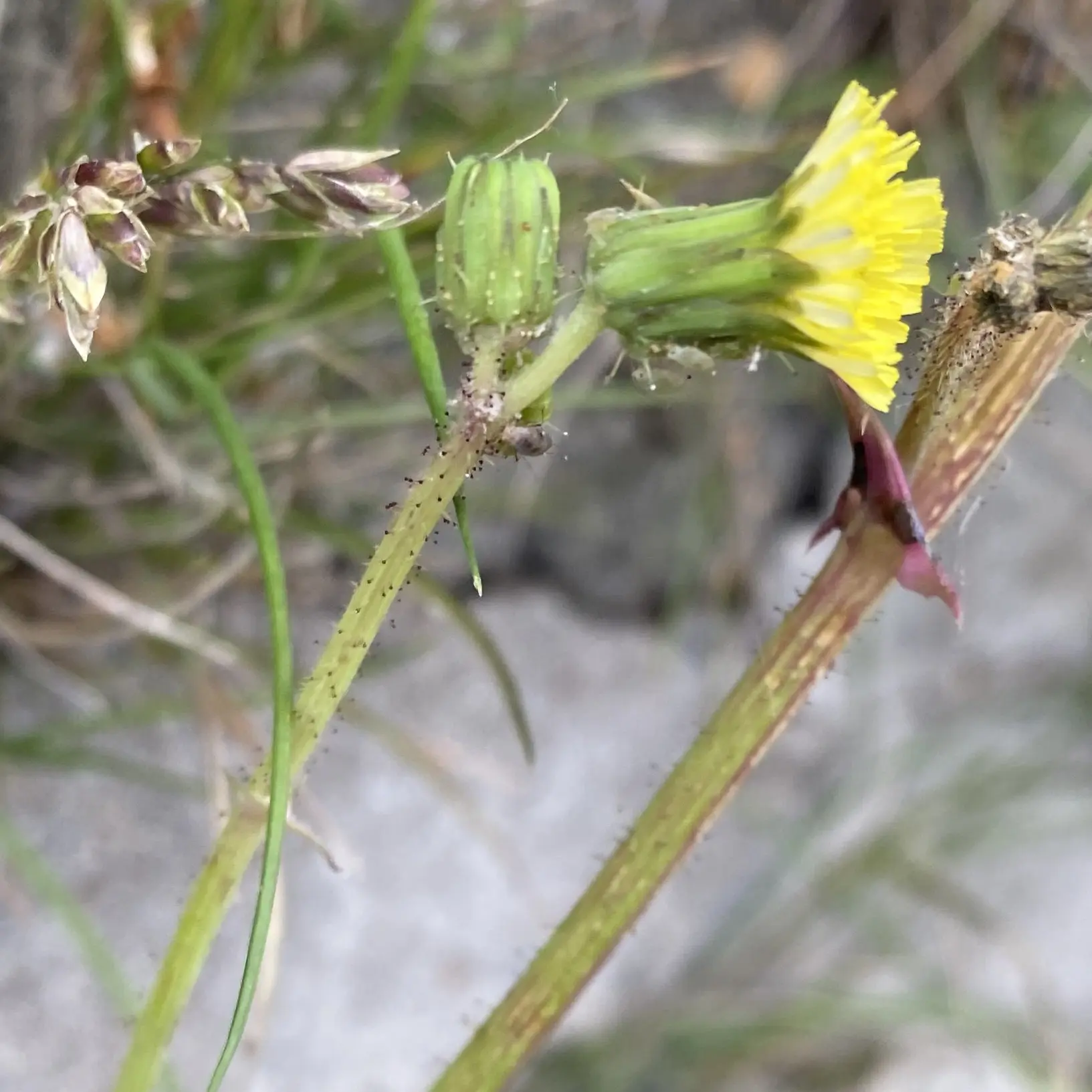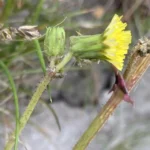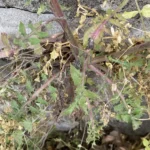Γαλατούνα, Τζιόγχος, Γαλατόχορτον, Σόγχος ο τραχύς υποείδος ο τραχύς
Etymology of Sonchus asper subspecies asper
"Sonchus" was called in ancient Greece "σόγχος" [sonkhos] and "σόγκος" [sogos], but the etymology is of unknown origin (the word could be Pre-Greek). The name is nevertheless from the classical times mentioned by Theophrastus and Dioscorides. Latin "asper" means "rough, sharp, coarse", referring to the rough feeling of its leaves' prickly margins.
Description of Sonchus asper subsp. asper (Prickly Sow-thistle)
General Habit
Sonchus asper subsp. asper is an annual or biennial herbaceous plant in the Asteraceae family. It typically reaches heights of 30 to 150 cm, with an upright, branched stem that exudes milky latex when broken. The plant has a robust, weedy appearance, often thriving in disturbed soils, roadsides, and field margins. It can form dense patches, especially in nutrient-rich environments.
Leaves
The leaves are one of the most diagnostic features of this subspecies. Basal and lower stem leaves are oblong to obovate, deeply lobed or pinnatifid, and have strongly undulate (wavy), spiny margins. The sharp, stiff spines, give the plant a distinctly prickly texture. While the leaf blades are generally glabrous, the midribs on the underside may bear fine, sparse, stiff hairs. The upper leaves reduce in size up the stem and are sessile, with amplexicaul (stem-clasping) auricles that are rounded to heart-shaped, often overlapping at the base of the stem.
Inflorescence and Flowers
The flowering heads (capitula) are typical of the dandelion-type (ligulate) Asteraceae, with all florets being yellow and strap-shaped (ligulate). The capitula are borne in loose corymbose panicles, with each head measuring 1.5 to 2.5 cm in diameter. The involucre is cylindrical to ovoid, composed of two rows of green bracts, which in this subspecies are typically glabrous or very sparsely hairy, sometimes glandular at the base. The peduncles immediately below the flower heads and the involucral bracts (the overlapping green structures surrounding the base of the flower head) are characteristically and consistently bearing glandular hairs. These are typically stipitate-glandular hairs. This term refers to hairs that consist of a stalk (stipe) and are topped by a small, often rounded, secretory gland. The glands are usually viscid (sticky) to the touch. The color of these glands can vary but are frequently described as dark, often reddish-brown or blackish, giving a distinctive appearance to the upper stem, peduncles, and involucre. The density of these glandular hairs can vary from sparse to dense, but their presence is a hallmark of Sonchus asper subsp. asper.
Stem and Surface Features
The stem is erect, hollow, and ridged, ranging in color from green to reddish-purple. It is slightly to moderately hairy, particularly around the nodes and inflorescence branches, with glandular hairs often visible under magnification. The plant is latex-bearing, which becomes apparent if any part is damaged or broken.
Fruit and Seeds
The fruit is a cypsela, typical of the Asteraceae family. It is brown, flattened, and ribbed, with a pappus of soft white hairs that aids in wind dispersal. The seeds are often dispersed over a wide area by the wind, which contributes to the species' invasive tendencies in some regions.
Important Differences from Sonchus oleraceus and Sonchus tenerrimus
While all three Sonchus species share some superficial resemblances, several key characteristics allow for their clear differentiation. Sonchus asper subspecies asper has similarities mostly with Sonchus oleracues and tenerrimus, let's take a look at some key differences:
Distinguishing Sonchus asper subspecies asper from Sonchus oleraceus (Smooth Sow-thistle)
Leaf Margins: The most distinguishing feature is the nature of the leaf margins. Sonchus asper has rigid, coarsely undulate leaves with sharply spiny margins, giving them a distinctly tough and prickly texture. In contrast, Sonchus oleraceus has softer, more tender leaves with weakly toothed to mildly spiny margins, often much less rigid and non-prickly to the touch.
Involucral Bracts: In Sonchus asper, the involucral bracts are usually glandular-hairy, especially near the margins and tips, and often bear dark reddish-brown glandular trichomes that can be sticky to the touch. However, some individuals may exhibit almost glabrous or glabrous bracts, particularly in drier habitats or late in the flowering season. In contrast, Sonchus oleraceus typically has glabrous or nearly glabrous involucral bracts, although occasional sparse glandular hairs may occur. These hairs, if present, are generally fewer, finer, and less conspicuous than in S. asper.
Achenes (Seeds): A definitive difference, if mature seeds are available for examination, is the achene morphology. Sonchus asper achenes are smooth or only very faintly tuberculate between their longitudinal ribs. In stark contrast, Sonchus oleraceus achenes are characterized by distinctive transverse wrinkles between the longitudinal ribs.
Distinguishing Sonchus asper subspecies asper from Sonchus tenerrimus (Slender Sow-thistle)
Overall Habit and Leaf Morphology: Sonchus asper is generally a more robust, stout, and erect plant with broader leaves that are often less deeply lobed. Sonchus tenerrimus, conversely, is typically more slender and delicate, often branching extensively from its base, leading to a bushier appearance. Its leaves are frequently very deeply and finely dissected or lobed, with narrower, almost linear segments, giving them a more delicate, fern-like or feathery aspect. While also spiny, the spines on S. tenerrimus are typically less rigid and prominent than those of S. asper.
Involucral Bracts: While both can have glabrous bracts, Sonchus asper commonly features glandular-hairy bracts. However, Sonchus tenerrimus involucral bracts are often, and notably, glabrous or eglandular.
Achenes (Seeds): While both differ from S. oleraceus, Sonchus asper achenes are generally smooth or very faintly tuberculate between their ribs. Sonchus tenerrimus achenes are typically transversely rugulose or tuberculate between the ribs, providing a roughened texture, though often less pronounced than the distinct wrinkles of S. oleraceus.
Ecology and Habitat
Sonchus asper subsp. asper is a ruderal species, meaning it is well-adapted to colonize disturbed environments. It is commonly found along roadsides, waste areas, field margins, and open habitats, and is well-adapted to a Mediterranean climate, such as in Cyprus. Its ability to thrive in poor soil and tolerate drought and trampling makes it a persistent weed in many areas.



